Fabric–Metal Barrier for Low Specific Absorption Rate and Wide-Band Felt Substrate Antenna for Medical and 5G Applications
Abstract
:1. Introduction
2. Antenna Design and Parametric Study
3. Antenna Performance and SAR Evaluation (in Free Space/on Human Body)
4. Sar Measurements in Flat Phantom
5. Conclusions
Author Contributions
Funding
Conflicts of Interest
References
- Ashap, A.Y.I.; Abidin, Z.Z.; Dahlan, S.H.; Majid, H.A.; Yee, S.K.; Saleh, G.; Malek, N.A. Flexible Wearable Antenna on Electromagnetic Band Gap using PDMS substrate. Telecommun. Comput. Electron. Control 2017, 15, 1454. [Google Scholar] [CrossRef] [Green Version]
- Ashyap, A.Y.I.; Marzudi, W.N.N.W.; Abidin, Z.Z.; Dahlan, S.H.; Majid, H.A.; Kamaruddin, M.R. Antenna incorporated with Electromagnetic Bandgap (EBG) for wearable application at 2.4 GHz wireless bands. In Proceedings of the 2016 IEEE Asia-Pacific Conference on Applied Electromagnetics (APACE), Langkawi, Malaysia, 11–13 December 2016; pp. 217–221. [Google Scholar] [CrossRef]
- Muhammad, Z.; Shah, S.M.; Abidin, Z.Z.; Asyhap, A.Y.I.; Mustam, S.M.; Ma, Y. CPW-Fed Wearable Antenna at 2.4 GHz ISM Band; AIP Publishing LLC.: Melville, NY, USA, 2017; p. 020003. [Google Scholar] [CrossRef] [Green Version]
- Gao, G.-P.; Yang, C.; Hu, B.; Zhang, R.-F.; Wang, S.-F. A Wide-Bandwidth Wearable All-Textile PIFA With Dual Resonance Modes for 5 GHz WLAN Applications. IEEE Trans. Antennas Propag. 2019, 67, 4206–4211. [Google Scholar] [CrossRef]
- Ashyap, A.Y.I.; Abidin, Z.Z.; Dahlan, S.H.; Majid, H.A.; Kamarudin, M.R.; Abd-Alhameed, R.A. Robust low-profile electromagnetic band-gap-based on textile wearable antennas for medical application. In Proceedings of the 2017 International Workshop on Antenna Technology: Small Antennas, Innovative Structures, and Applications (iWAT), Athens, Greece, 1–3 March 2017; pp. 158–161. [Google Scholar] [CrossRef]
- Alani, S.; Zakaria, Z.; Ahmad, A. Miniaturized UWB elliptical patch antenna for skin cancer diagnosis imaging. Int. J. Electr. Comput. Eng. 2020, 10, 1422–1429. [Google Scholar] [CrossRef]
- Jiang, Z.H.; Brocker, D.E.; Sieber, P.E.; Werner, D.H.; Compact, A. Low-Profile Metasurface-Enabled Antenna for Wearable Medical Body-Area Network Devices. IEEE Trans. Antennas Propag. 2014, 62, 4021–4030. [Google Scholar] [CrossRef]
- Soh, P.J.; Vandenbosch, G.; Wee, F.H.; van den Bosch, A.; Martinez-Vazquez, M.; Schreurs, D. Specific Absorption Rate (SAR) Evaluation of Textile Antennas. IEEE Antennas Propag. Mag. 2015, 57, 229–240. [Google Scholar] [CrossRef]
- Ashyap, A.Y.I.; Abidin, Z.Z.; Dahlan, S.H.; Majid, H.A.; Seman, F.C. A Compact Wearable Antenna Using EBG for Smart-Watch Applications. In Proceedings of the 2018 Asia-Pacific Microwave Conference (APMC), Kyoto, Japan, 6–9 November 2018; pp. 1477–1479. [Google Scholar] [CrossRef]
- Alkhalaf, H.Y.; Ahmad, M.Y.; Ramiah, H. Self-Sustainable Biomedical Devices Powered by RF Energy: A Review. Sensors 2022, 22, 6371. [Google Scholar] [CrossRef]
- Lak, A.; Adelpour, Z.; Oraizi, H.; Parhizgar, N. Design and SAR assessment of three compact 5G antenna arrays. Sci. Rep. 2021, 11, 21265. [Google Scholar] [CrossRef]
- Agarwal, K.; Guo, Y.-X.; Salam, B. Wearable AMC Backed Near-Endfire Antenna for On-Body Communications on Latex Substrate. IEEE Trans. Compon. Packag. Manuf. Technol. 2016, 6, 346–358. [Google Scholar] [CrossRef]
- Kheifets, L.; Repacholi, M.; Saunders, R.; van Deventer, E. The Sensitivity of Children to Electromagnetic Fields. Pediatrics 2005, 116, e303–e313. [Google Scholar] [CrossRef] [Green Version]
- Nylund, R.; Leszczynski, D. Mobile phone radiation causes changes in gene and protein expression in human endothelial cell lines and the response seems to be genome- and proteome-dependent. Proteomics 2006, 6, 4769–4780. [Google Scholar] [CrossRef]
- Olakunle, A.; Kayode, J.; Adewale, F. Overview of Cellular Damage in Abnormal Absorption of Magnetic and Radio Waves: Implications among Cell-Phone Users. Available online: https://www.researchgate.net/publication/287643628 (accessed on 30 December 2015).
- Qian, Y.; Yang, Y.F.R.; Itoh, T. Novel Planer band gab structures forfor antenna applications. In Proceedings of the AP2000 Millennium Conferance on Antenna and Propagation, Davos, Switzerland, 9–14 April 2000. [Google Scholar]
- Salonen, P.; Hurme, L. A novel fabric WLAN antenna for wearable applications. In Proceedings of the IEEE Antennas and Propagation Society International Symposium. Digest. Held in conjunction with: USNC/CNC/URSI North American Radio Sci. Meeting (Cat. No.03CH37450), Columbus, OH, USA, 11 August 2003; pp. 700–703. [Google Scholar] [CrossRef]
- Ashyap, A.Y.I.; Abidin, Z.Z.; Dahlan, S.H.; Majid, H.A.; Kamarudin, M.R.; Alomainy, A.; Abd-Alhameed, R.A.; Kosha, J.S.; Noras, J.M. Highly Efficient Wearable CPW Antenna Enabled by EBG-FSS Structure for Medical Body Area Network Applications. IEEE Access 2018, 6, 77529–77541. [Google Scholar] [CrossRef]
- Alibakhshikenari, M.; Virdee, B.S.; Shukla, P.; Parchin, N.O.; Azpilicueta, L.; See, C.H.; Abd-Alhameed, R.A.; Falcone, F.; Huynen, I.; Denidni, T.A.; et al. Metamaterial-inspired antenna array for application in microwave breast imaging systems for tumor detection. IEEE Access 2020, 8, 174667–174678. [Google Scholar] [CrossRef]
- Alibakhshikenari, M.; Virdee, B.S.; See, C.H.; Shukla, P.; Moghaddam, S.M.; Zaman, A.U.; Shafqaat, S.; Akinsolu, M.O.; Liu, B.; Yang, J.; et al. Dual-Polarized Highly Folded Bowtie Antenna With Slotted Self-Grounded Structure for Sub-6 GHz 5G Applications. IEEE Trans. Antennas Propag. 2022, 70, 3028–3033. [Google Scholar] [CrossRef]
- Alibakhshikenari, M.; Virdee, B.S.; Azpilicueta, L.; Naser-Moghadasi, M.; Akinsolu, M.O.; See, C.H.; Liu, B.; Abd-Alhameed, R.A.; Falcone, F.; Huynen, I.; et al. A Comprehensive Survey of “Metamaterial Transmission-Line Based Antennas: Design, Challenges, and Applications. IEEE Access 2020, 8, 144778–144808. [Google Scholar] [CrossRef]
- Alibakhshikenari, M.; Ali, E.M.; Soruri, M.; Dalarsson, M.; Naser-Moghadasi, M.; Virdee, B.S.; Stefanovic, C.; Pietrenko-Dabrowska, A.; Koziel, S.; Szczepanski, S.; et al. A Comprehensive Survey on Antennas On-Chip Based on Metamaterial, Metasurface, and Substrate Integrated Waveguide Principles for Millimeter-Waves and Terahertz Integrated Circuits and Systems. IEEE Access 2022, 10, 3668–3692. [Google Scholar] [CrossRef]
- Ashyap, A.Y.I.; Bin Dahlan, S.H.; Abidin, Z.Z.; Dahri, M.H.; Majid, H.A.; Kamarudin, M.R.; Yee, S.K.; Jamaluddin, M.H.; Alomainy, A.; Abbasi, Q.H. Robust and Efficient Integrated Antenna With EBG-DGS Enabled Wide Bandwidth for Wearable Medical Device Applications. IEEE Access 2020, 8, 56346–56358. [Google Scholar] [CrossRef]
- Jin, C.; Chen, J.; Zhang, B.; Kong, L.; An, S.; He, Z.S.; Liu, J. Low-Cost mmWave Metallic Waveguide Based on Multilayer Integrated Vertical-EBG Structure and its Application to Slot Array Antenna Design. IEEE Trans. Antennas Propag. 2022, 70, 2205–2213. [Google Scholar] [CrossRef]
- Xiong, H.Q.; Zhang, C.J.; Tong, M.S. Wideband Low-Profile Dual-Polarized Antenna Based on a Gain-Enhanced EBG Reflector. IEEE Trans. Compon. Packag. Manuf. Technol. 2022, 12, 391–394. [Google Scholar] [CrossRef]
- Megahed, A.A.; Abdelazim, M.; Abdelhay, E.H.; Soliman, H.Y.M. Sub-6 GHz Highly Isolated Wideband MIMO Antenna Arrays. IEEE Access 2022, 10, 19875–19889. [Google Scholar] [CrossRef]
- Sambandam, P.; Kanagasabai, M.; Ramadoss, S.; Natarajan, R.; Alsath, M.G.N.; Shanmuganathan, S.; Sindhadevi, M.; Palaniswamy, S.K. Compact Monopole Antenna Backed With Fork-Slotted EBG for Wearable Applications. IEEE Antennas Wirel. Propag. Lett. 2020, 19, 228–232. [Google Scholar] [CrossRef]
- Fang, X.; Wen, G.; Inserra, D.; Huang, Y.; Li, J. Compact Wideband CPW-Fed Meandered-Slot Antenna With Slotted Y-Shaped Central Element for Wi-Fi, WiMAX, and 5G Applications. IEEE Trans. Antennas Propag. 2018, 66, 7395–7399. [Google Scholar] [CrossRef]
- Naik, K.K.; Dattatreya, G.; Chaitanya, R.P.; Palla, R.; Rani, S.S. Enhancement of gain with corrugated Y-shaped patch antenna for triple-band applications. Int. J. RF Microw. Comput. Aided Eng. 2019, 29, e21624. [Google Scholar] [CrossRef]
- Singh, A.; Ansari, J.A.; Kamakshi, D.; Aneesh, M.; Sayeed, S.S. Analysis of slot loaded compact patch antennas for dualband operation. Int. J. Appl. Electromagn. Mech. 2015, 47, 163–175. [Google Scholar] [CrossRef]
- Mantash, M.; Tarot, A.-C.; Collardey, S.; Mahdjoubi, K. Investigation of Flexible Textile Antennas and AMC Reflectors. Int. J. Antennas Propag. 2012, 2012, 236505. [Google Scholar] [CrossRef] [Green Version]
- Schab, K.; Jelinek, L.; Capek, M.; Ehrenborg, C.; Tayli, D.; Vandenbosch, G.A.E.; Gustafsson, M. Energy Stored by Radiating Systems. IEEE Access 2018, 6, 10553–10568. [Google Scholar] [CrossRef]
- Abbasi, M.A.B.; Nikolaou, S.S.; Antoniades, M.A.; Stevanovic, M.N.; Vryonides, P. Compact EBG-Backed Planar Monopole for BAN Wearable Applications. IEEE Trans. Antennas Propag. 2017, 65, 453–463. [Google Scholar] [CrossRef] [Green Version]
- Raad, H.R.; Abbosh, A.I.; Al-Rizzo, H.M.; Rucker, D.G. Flexible and Compact AMC Based Antenna for Telemedicine Applications. IEEE Trans. Antennas Propag. 2013, 61, 524–531. [Google Scholar] [CrossRef]
- Abirami, B.S.; Sundarsingh, E.F. EBG-Backed Flexible Printed Yagi–Uda Antenna for On-Body Communication. IEEE Trans. Antennas Propag. 2017, 65, 3762–3765. [Google Scholar] [CrossRef]
- El Atrash, M.; Abdalla, M.A.; Elhennawy, H.M. A Wearable Dual-Band Low Profile High Gain Low SAR Antenna AMC-Backed for WBAN Applications. IEEE Trans. Antennas Propag. 2019, 67, 6378–6388. [Google Scholar] [CrossRef]
- Musa, U.; Shah, S.M.; Majid, H.A.; Mahadi, I.A.; Rahim, M.K.A.; Yahya, M.S.; Abidin, Z.Z. Design and Analysis of a Compact Dual-Band Wearable Antenna for WBAN Applications. IEEE Access 2023, 11, 30996–31009. [Google Scholar] [CrossRef]
- Le, T.T.; Kim, Y.-D.; Yun, T.-Y. Wearable Pattern-Diversity Dual-Polarized Button Antenna for Versatile On-/Off-Body Communications. IEEE Access 2022, 10, 98700–98711. [Google Scholar] [CrossRef]
- Hashim, F.F.; Mahadi, W.N.L.B.; Latef, T.B.A.; Othman, M.B. Key Factors in the Implementation of Wearable Antennas for WBNs and ISM Applications: A Review WBNs and ISM Applications: A Review. Electronics 2022, 11, 2470. [Google Scholar] [CrossRef]
- Hashim, F.F.; Mahadi, W.N.L.B.; Latef, T.B.A.; Othman, M.A.B. Wide-Band Felt Antenna With 6-Cells Electromagnetic Band Gap Jeans Array for Wireless Area Network Applications. In Proceedings of the International Technical Postgraduate Conference 2022, Kuala Lumpur, Malaysia, 24–25 September 2022; AIJR Proceedings. pp. 154–162. [Google Scholar] [CrossRef]
- Yin, J.; Ma, W.; Gao, Z.; Lei, X.; Jia, C. A Review of Electromagnetic Shielding Fabric, Wave-Absorbing Fabric and Wave-Transparent Fabric. Polymers 2022, 14, 377. [Google Scholar] [CrossRef] [PubMed]
- Tsang, L.; Kong, J.A. Scattering of electromagnetic waves from random media with strong permittivity fluctuations. Radio. Sci. 1981, 16, 303–320. [Google Scholar] [CrossRef]
- Lak, A.; Oraizi, H. Evaluation of SAR distribution in six-layer human head model. Int. J. Antennas Propag. 2013, 2013, 580872. [Google Scholar] [CrossRef]
- Gao, G.-P.; Hu, B.; Wang, S.-F.; Yang, C. Wearable Circular Ring Slot Antenna With EBG Structure for Wireless Body Area Network. IEEE Antennas Wirel. Propag. Lett. 2018, 17, 434–437. [Google Scholar] [CrossRef]
- Loader, B.; Gregory, A.P.; Mouthaan, R. Formulation and Properties of Liquid Phantoms, 1 MHz to 10 GHz. Available online: https://www.researchgate.net/publication/324918460 (accessed on 30 May 2018).
- Wang, B.; Yan, S. Design of Smartwatch Integrated Antenna With Polarization Diversity. IEEE Access 2020, 8, 123440–123448. [Google Scholar] [CrossRef]
- Boyuan, M.; Pan, J.; Wang, E.; Yang, D. Wristwatch-Style Wearable Dielectric Resonator Antennas for Applications on Limps. IEEE Access 2020, 8, 59837–59844. [Google Scholar] [CrossRef]
- Le, T.T.; Kim, Y.-D.; Yun, T.-Y. A Triple-Band Dual-Open-Ring High-Gain High-Efficiency Antenna for Wearable Applications. IEEE Access 2021, 9, 118435–118442. [Google Scholar] [CrossRef]
- Ahmed, S.; Le, D.; Sydanheimo, L.; Ukkonen, L.; Bjorninen, T. Wearable Metasurface-Enabled Quasi-Yagi Antenna for UHF RFID Reader With End-Fire Radiation Along the Forearm. IEEE Access 2021, 9, 77229–77238. [Google Scholar] [CrossRef]
- Wagih, M.; Komolafe, A.; Weddell, A.S.; Beeby, S. Broadband Compact Substrate-Independent Textile Wearable Antenna for Simultaneous Near- and Far-Field Wireless Power Transmission. IEEE Open J. Antennas Propag. 2022, 3, 398–411. [Google Scholar] [CrossRef]
- Smida, A.; Iqbal, A.; Alazemi, A.J.; Waly, M.I.; Ghayoula, R.; Kim, S. Wideband Wearable Antenna for Biomedical Telemetry Applications. IEEE Access 2020, 8, 15687–15694. [Google Scholar] [CrossRef]
- Liao, C.-T.; Yang, Z.-K.; Chen, H.-M. Multiple Integrated Antennas for Wearable Fifth-Generation Communication and Internet of Things Applications. IEEE Access 2021, 9, 120328–120346. [Google Scholar] [CrossRef]
- Nguyen, D.; Seo, C. An Ultra-Miniaturized Antenna Using Loading Circuit Method for Medical Implant Applications. IEEE Access 2021, 9, 111890–111898. [Google Scholar] [CrossRef]
- Li, Y.J.; Lu, Z.Y.; Yang, L.S. CPW-Fed Slot Antenna for Medical Wearable Applications. IEEE Access 2019, 7, 42107–42112. [Google Scholar] [CrossRef]
- Li, J.; Jiang, Y.; Zhao, X. Circularly Polarized Wearable Antenna Based on NinjaFlex-Embedded Conductive Fabric. Int. J. Antennas Propag. 2019, 2019, 3059480. [Google Scholar] [CrossRef] [Green Version]
- Mu, G.; Ren, P. A Compact Dual-Band Metasurface-Based Antenna for Wearable Medical Body-Area Network Devices. J. Electr. Comput. Eng. 2020, 2020, 4967198. [Google Scholar] [CrossRef]
- Azeez, H.; Yang, H.-C.; Chen, W.-S. Wearable Triband E-Shaped Dipole Antenna with Low SAR for IoT Applications. Electronics 2019, 8, 665. [Google Scholar] [CrossRef] [Green Version]
- Ali, H.; Ren, X.-C.; Bari, I.; Bashir, M.A.; Hashmi, A.M.; Khan, M.A.; Majid, S.I.; Jan, N.; Tareen, W.U.K.; Anjum, M.R. Four-Port MIMO Antenna System for 5G n79 Band RF Devices. Electronics 2021, 11, 35. [Google Scholar] [CrossRef]
- Hei, Y.; Wang, M.; Wu, W.; Wu, Y. A Fabry-Perot Cavity Antenna With Non-Uniform Superstrate and EBG Ground for High Gain and High Aperture Efficiency. IEEE Access 2021, 9, 101239–101245. [Google Scholar] [CrossRef]
- Dey, S.; Dey, S.; Koul, S.K. Isolation Improvement of MIMO Antenna Using Novel EBG and Hair-Pin Shaped DGS at 5G Millimeter Wave Band. IEEE Access 2021, 9, 162820–162834. [Google Scholar] [CrossRef]
- Wu, T.; Chen, J.; Wu, P.-F. Multi-Mode High-Gain Antenna Array Loaded With High Impedance Surface. IEEE Access 2020, 8, 147070–147076. [Google Scholar] [CrossRef]
- Kong, L.; Yan, S.; Volskiy, V.; Huang, B.; Vandenbosch, G.A.E. Leaky Wave Array in Full Planar Substrate with EBG-Based Wave Guiding Channel. Int. J. Antennas Propag. 2021, 2021, 5527445. [Google Scholar] [CrossRef]
- Wang, S.; Gao, H. A Dual-Band Wearable Conformal Antenna Based on Artificial Magnetic Conductor. Int. J. Antennas Propag. 2022, 2022, 9970477. [Google Scholar] [CrossRef]
- Xie, T.; Yu, J.; Lin, Z.; Li, Y.; Zhang, G.; Yu, Z.; Dual-Band, A.N. “C+O” Structure Antenna. Int. J. Antennas Propag. 2021, 2021, 7974349. [Google Scholar] [CrossRef]
- He, W.; He, Y.; Zhang, L.; Wong, S.-W.; Li, W.; Boag, A. A Low-Profile Circularly Polarized Conical-Beam Antenna with Wide Overlap Bandwidth. Wirel. Commun. Mob. Comput. 2021, 2021, 6648887. [Google Scholar] [CrossRef]


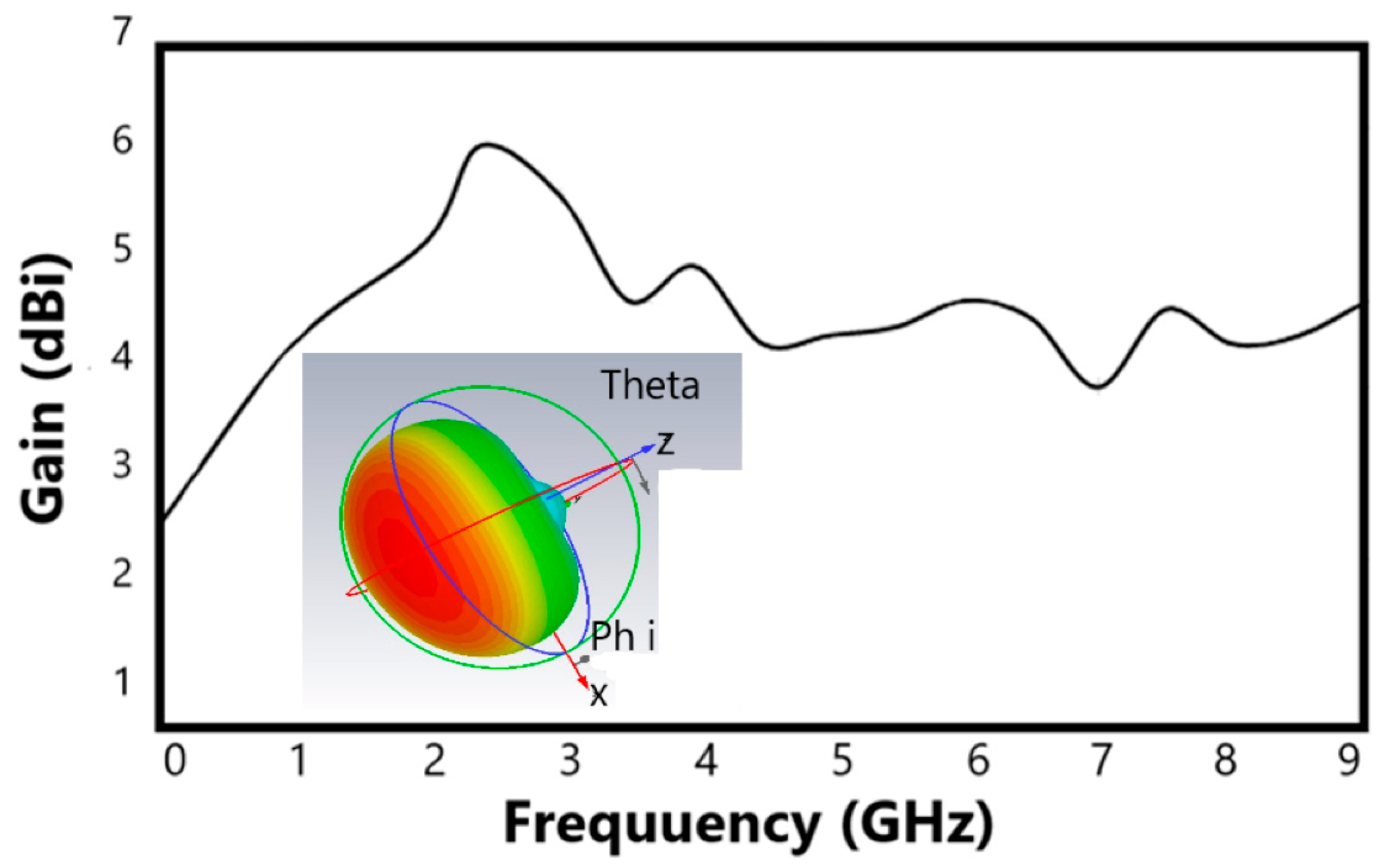
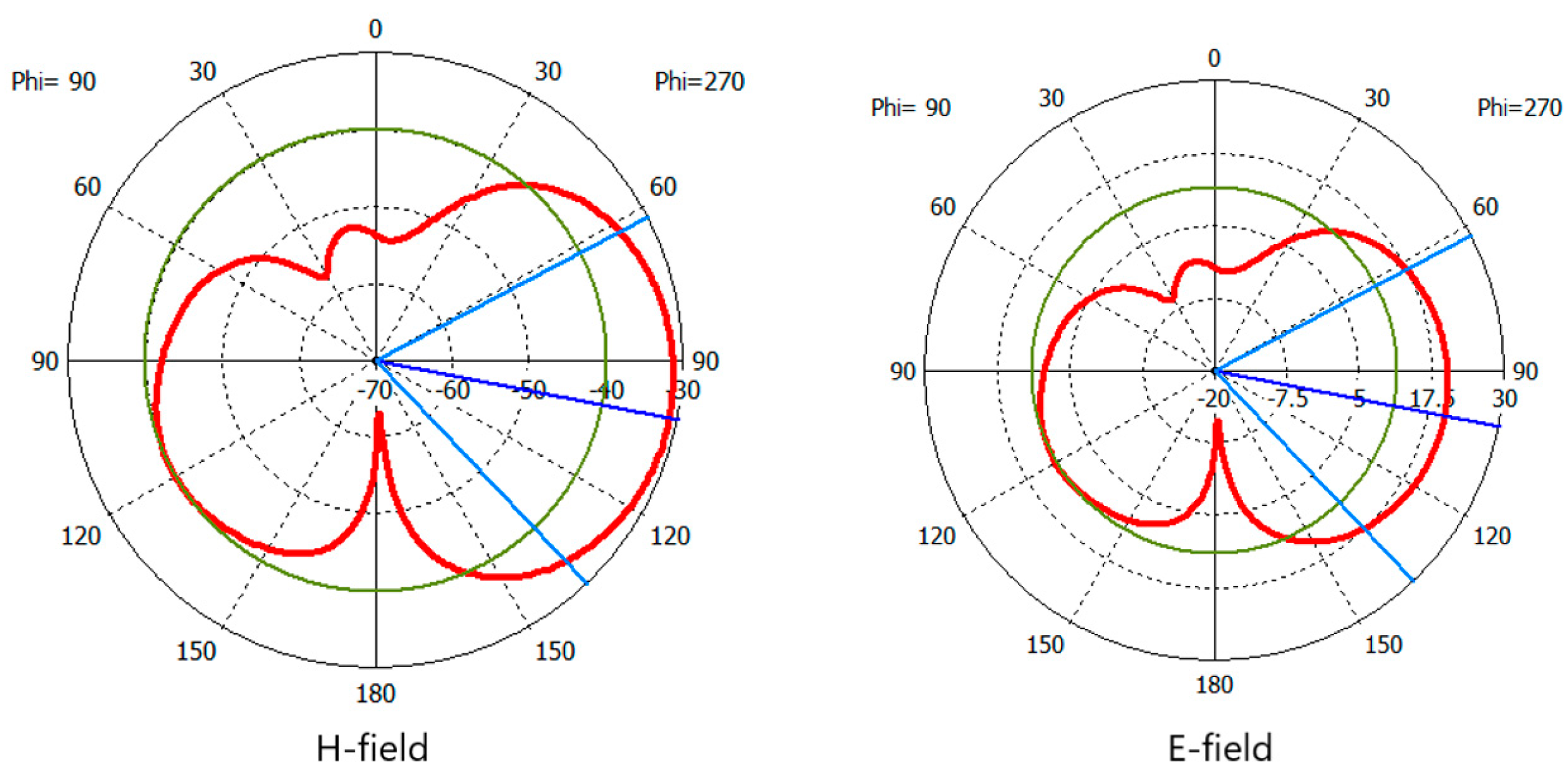


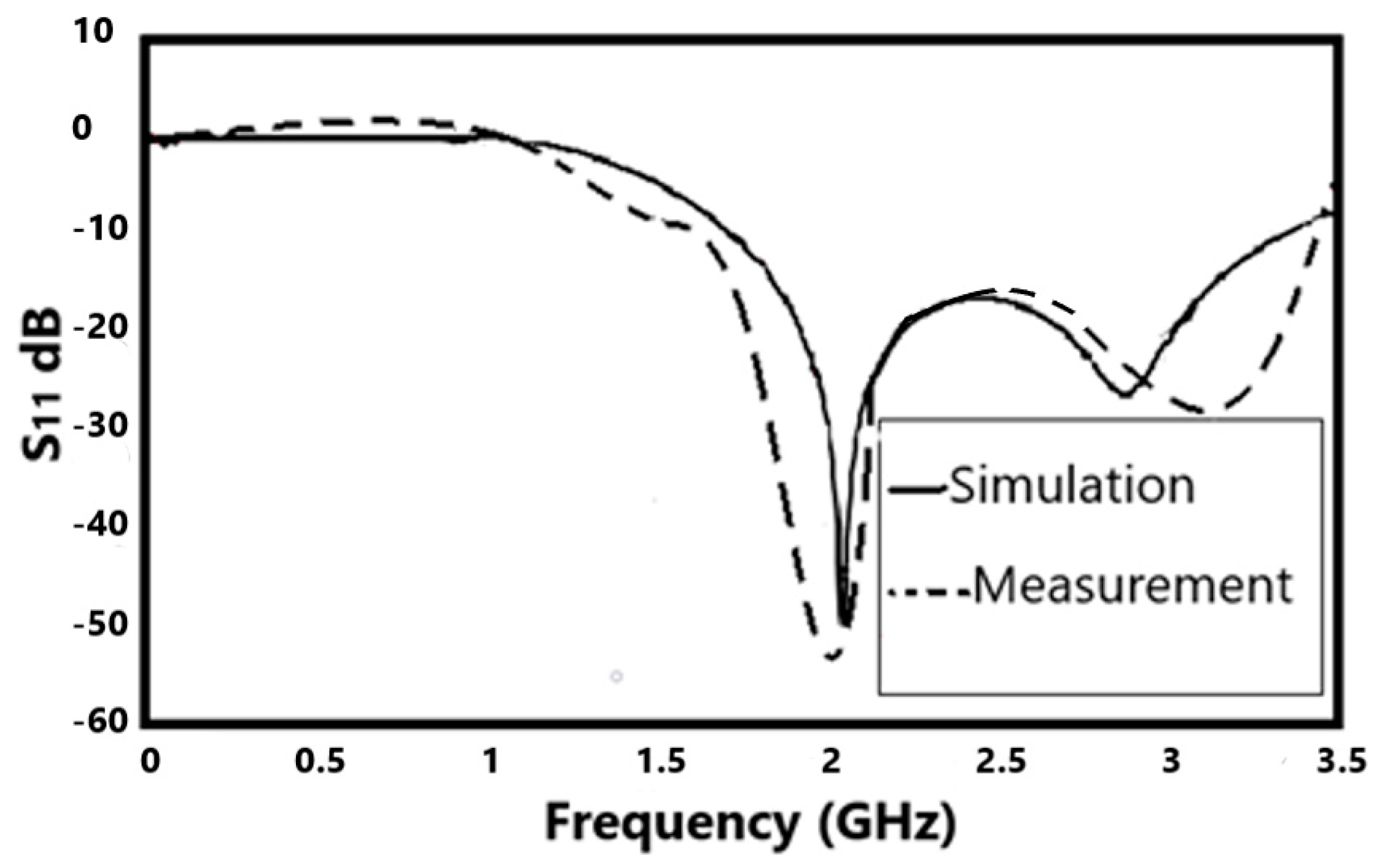
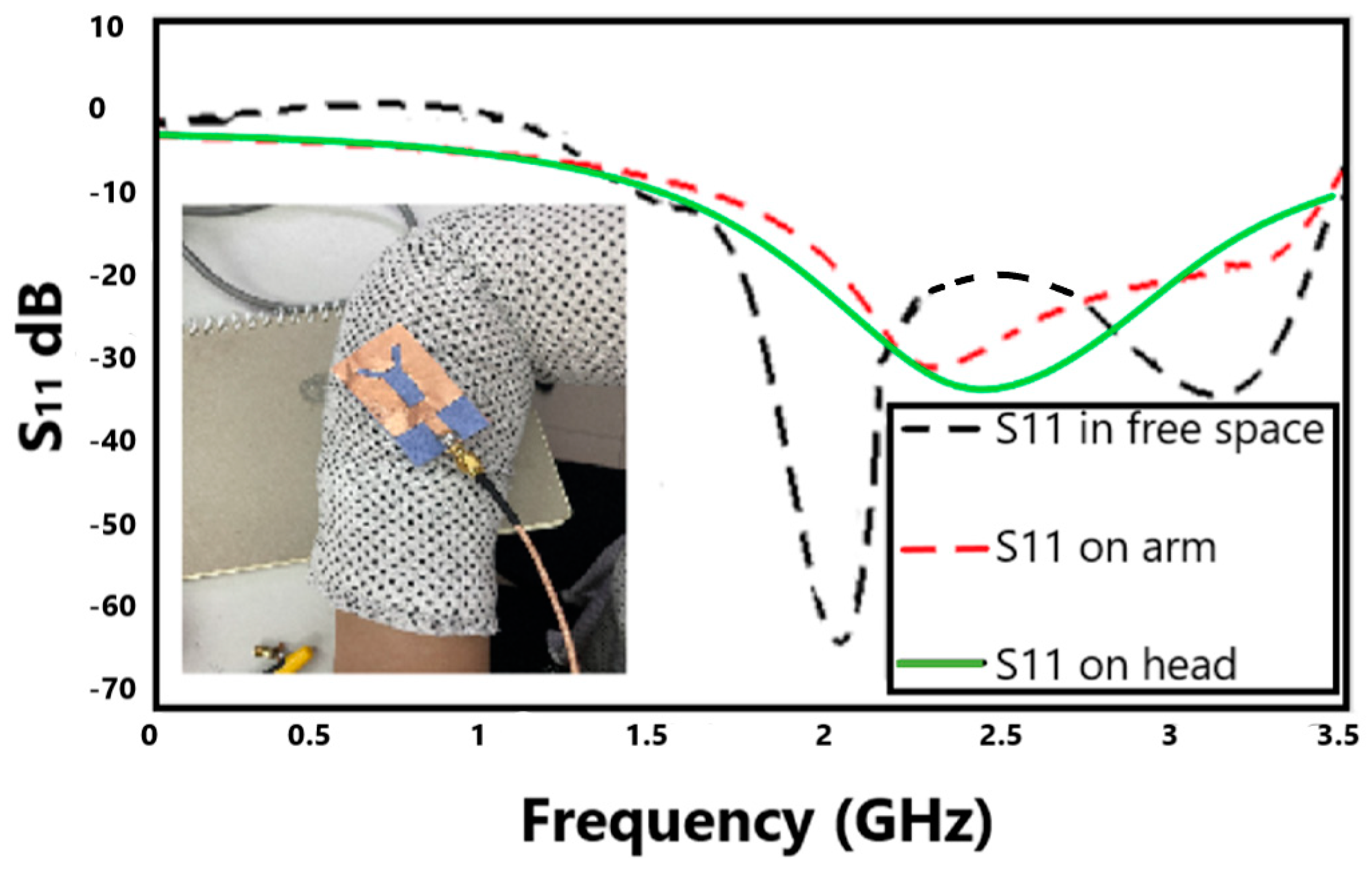
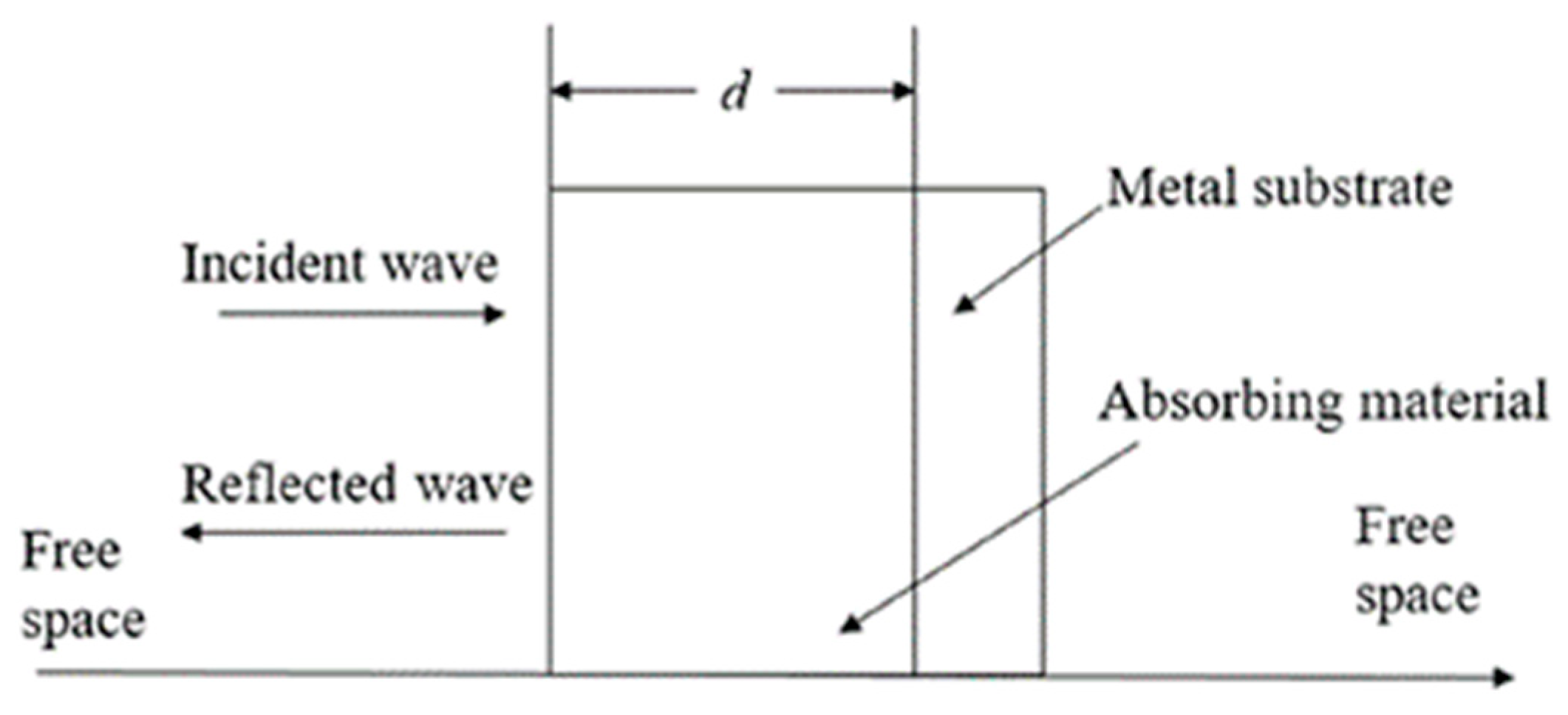
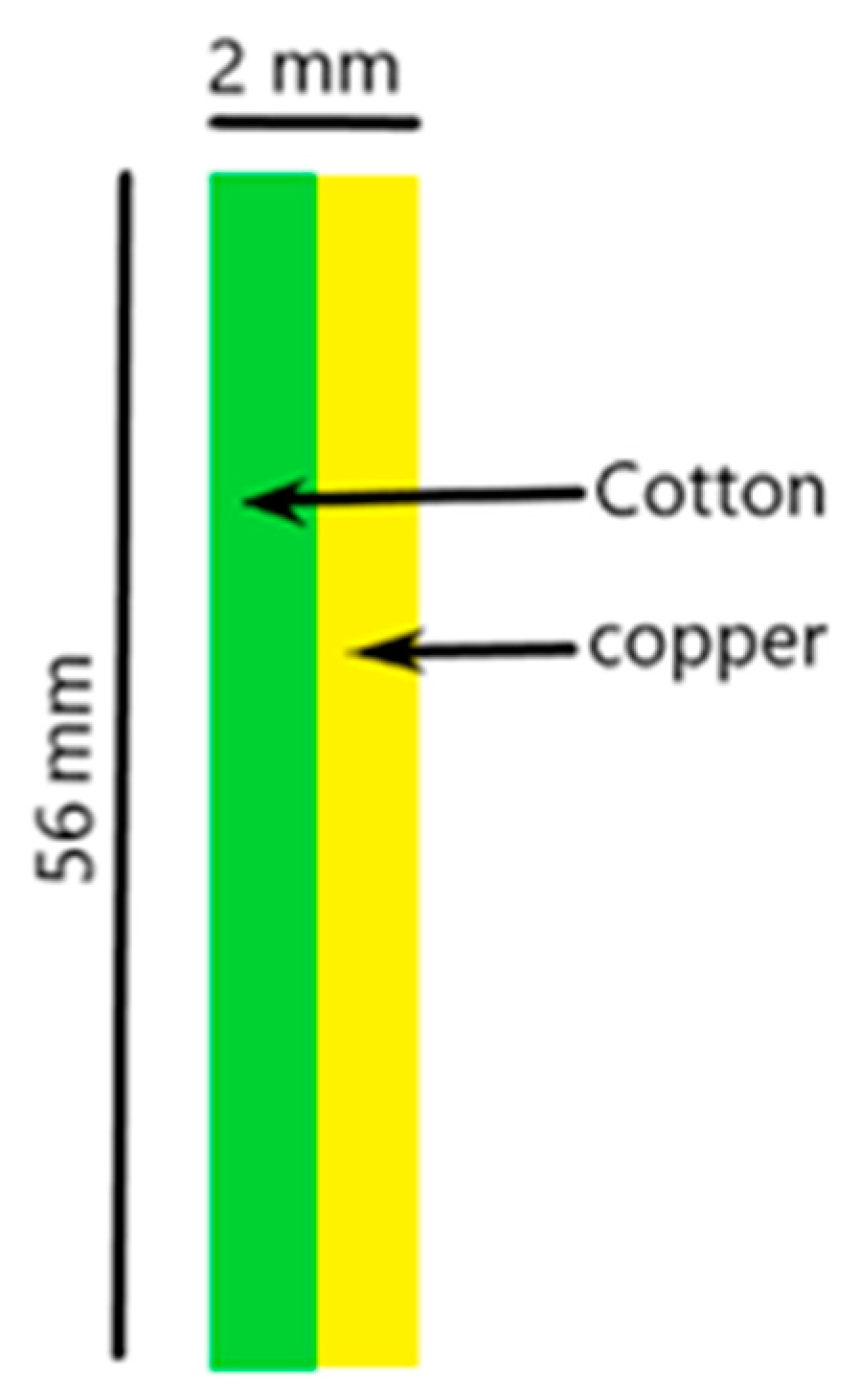


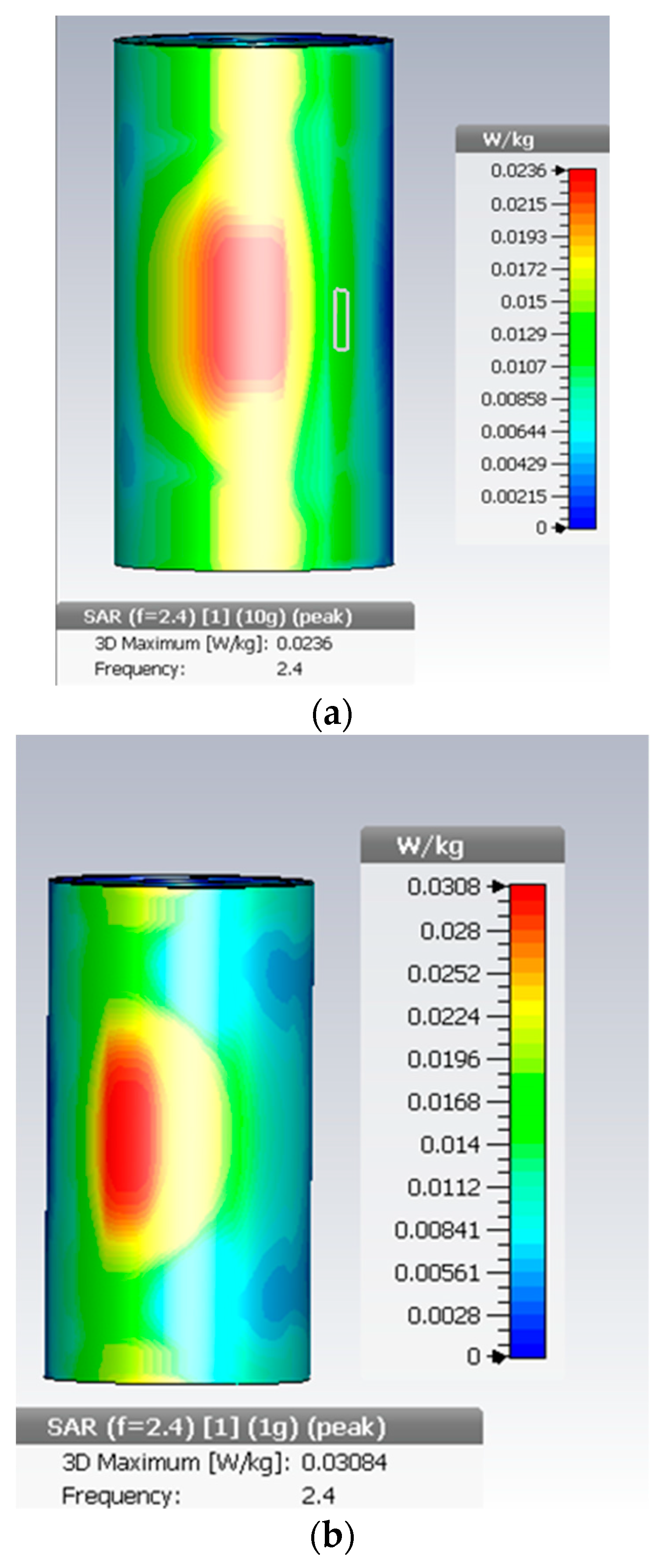
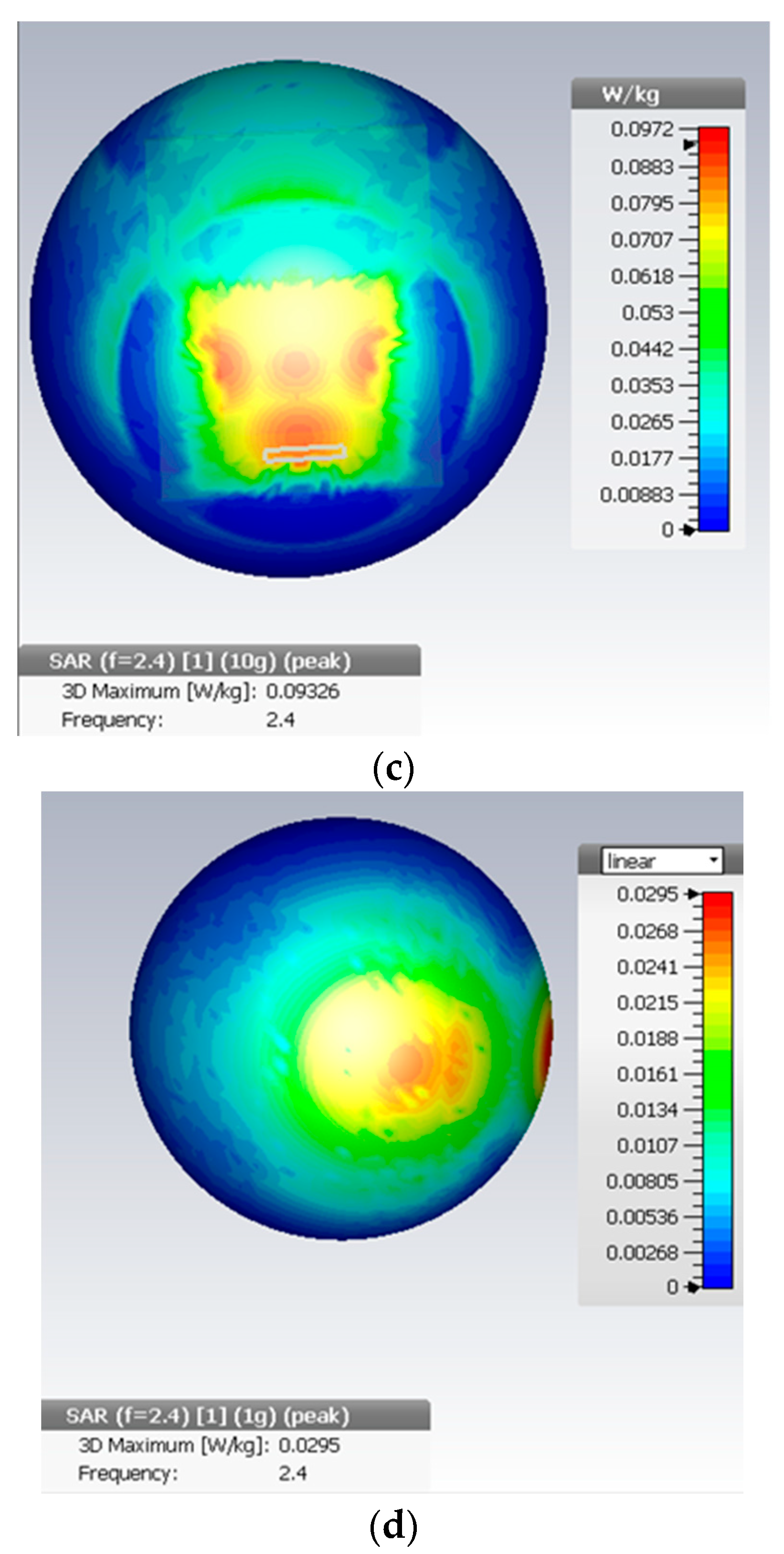
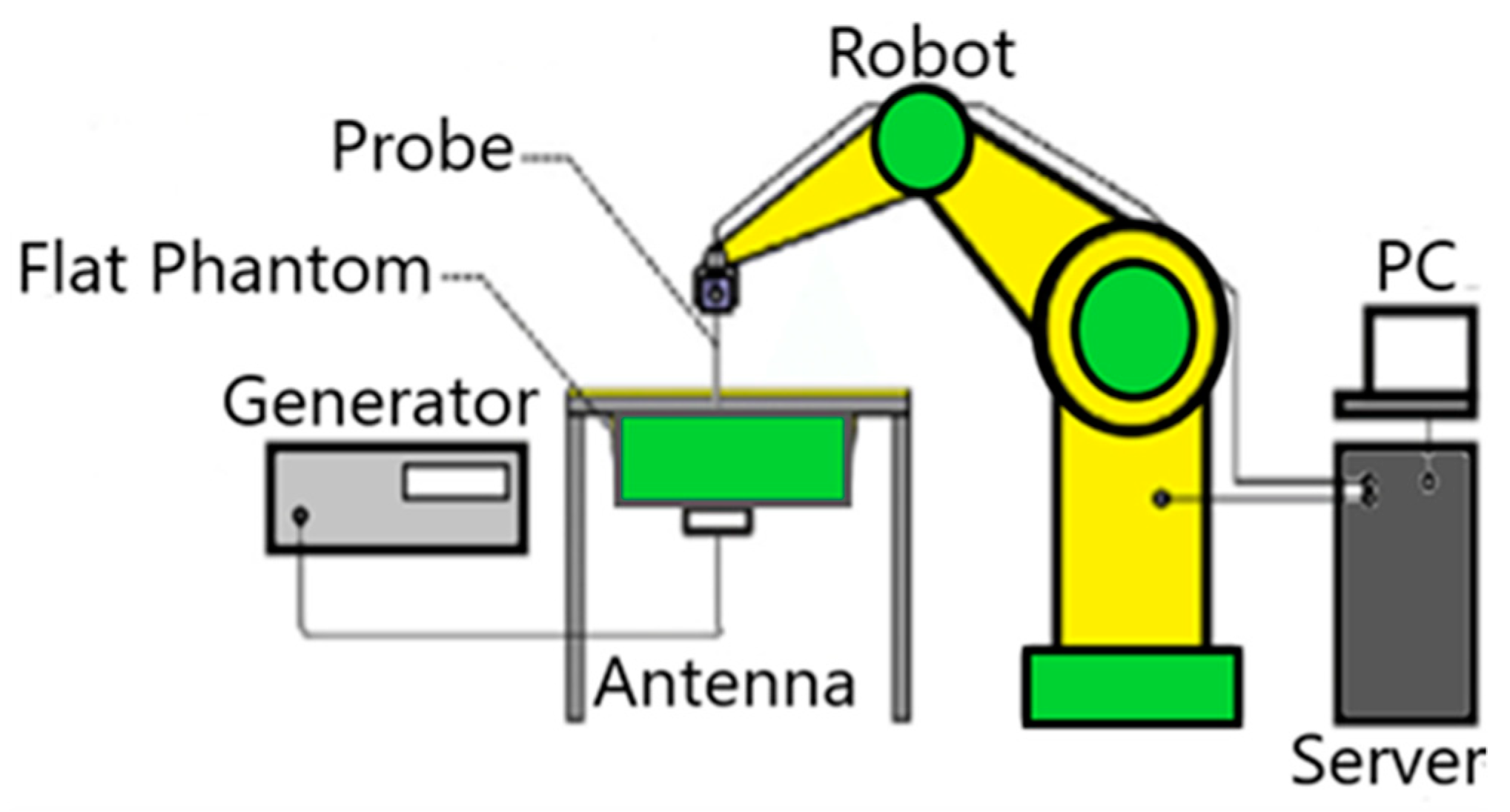
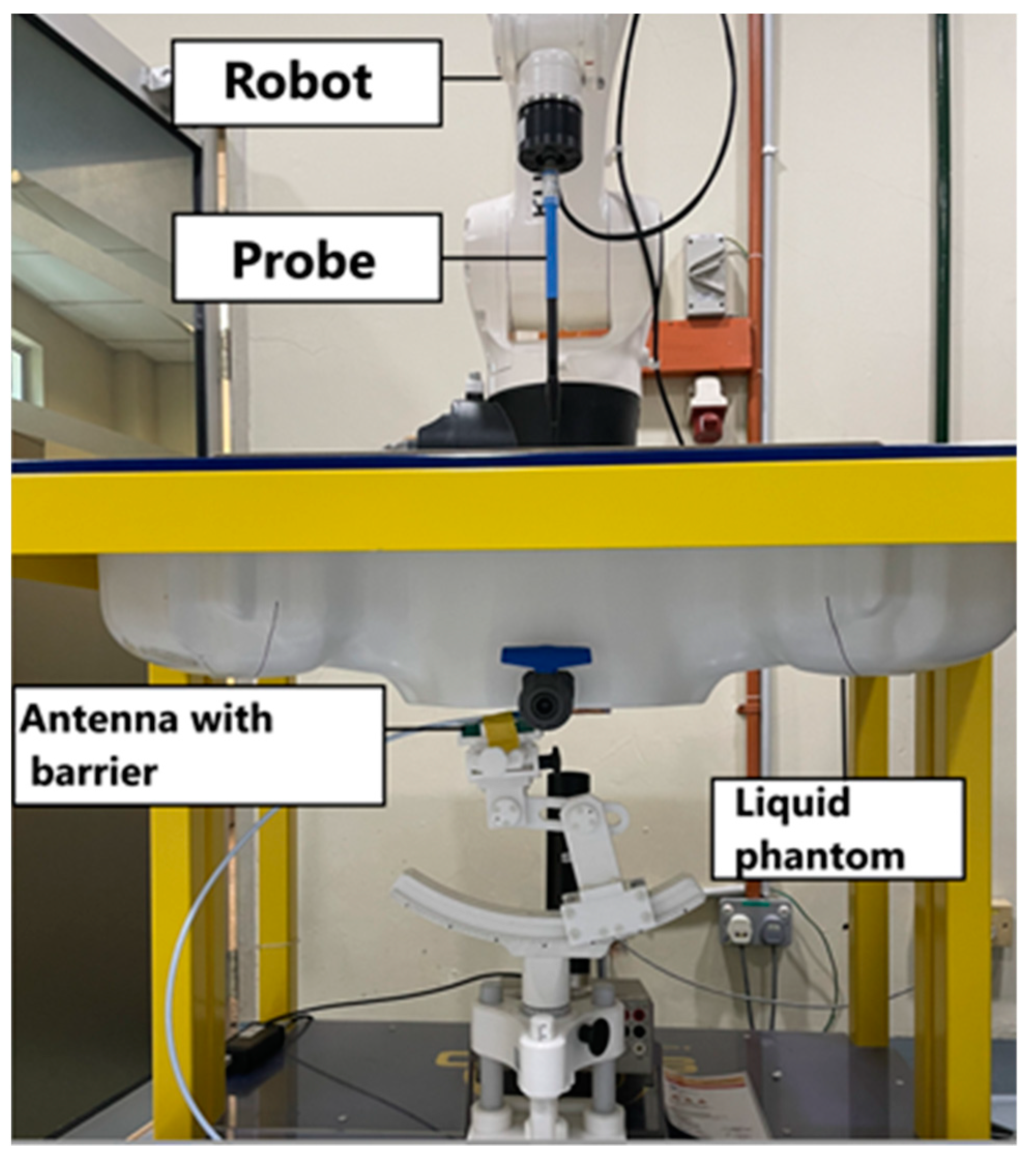
| Fat | Muscle | Bone | Skin | |
|---|---|---|---|---|
| Density (kg/m3) | 900 | 1006 | 1008 | 1001 |
| Permittivity (εr) | 5.27 | 52.67 | 18.49 | 37.95 |
| Conductivity (s/m) | 0.11 | 1.77 | 0.82 | 1.49 |
| Thickness (mm) | 5 | 20 | 13 | 2 |
| Tissue | Permittivity | Conductivity | Thickness (mm) |
|---|---|---|---|
| Skin | 40.7 | 0.65 | 1 |
| Fat | 10 | 0.17 | 0.14 |
| Bone | 20.9 | 0.33 | 0.41 |
| Brain | 41.1 | 0.86 | 81 |
| Target Properties | Ingredients by Weight | ||||
|---|---|---|---|---|---|
| σ S/m | Water % | Polysorbate (20%) | Polysorbate (80%) | NaCL % | |
| 39.2 | 1.8 | 55.75 | 45.25 | 0 | 0.00 |
| Ref. | Year | SAR (W/kg) (1 g) | SAR (W/kg) (10 g) |
|---|---|---|---|
| [46] | 2020 (sim) | 0.35 | 0.28 |
| [47] | 2020 (sim) | 1.22 | - |
| [48] | 2021 (sim) | 0.29/0.2/0.22 | 0.13/0.09/0.09 |
| [49] | 2021 (sim) | 0.9 | - |
| [50] | 2022 (sim) | 0.37 | 0.26 |
| [51] | 2020 (sim) | 5.95 | - |
| [52] | 2021 (sim) | 0.25 | 0.58 |
| [53] | 2021 (sim) | 36.3 | 44.5 |
| [54] | 2019 (sim) | 0.3 | - |
| [55] | 2019 (sim) | 0.6 | - |
| [56] | 2020 (sim) | 0.84 | - |
| [57] | 2019 (sim) | - | 1.5 |
| [58] | 2021 (sim) | 0.9 | - |
| This work | Measured (head) | 0.01 | 0.006 |
| This work | Simulated (Arm) | 0.03 | 0.02 |
| This work | Simulated (Head) | 0.02 | 0.09 |
| Work | B.W % | Substrate | Gain | SAR (W/Kg) | Design Method | Size |
|---|---|---|---|---|---|---|
| [23,24] | (9.3%) and (7.7%) | Metallic | - | - | EBG structure | - |
| [26] | 51 | FR-4 | - | - | EBG structure | 46 × 46 × 1.6 |
| [59] | 5.3 | Rogers 4360G2 | 24 | - | EBG structure | - |
| [60] | 20 | FR-4 | 9 | - | EBG and DGS | 80.6 × 25.6 |
| [61] | 32.8 | FR-4 | 18.8 | - | High impedance surface | 3.2 × 2.8 × 0.09 |
| [62] | 6.6 | full planar dielectric substrate | 11.36 | - | EBG structure | - |
| [23] | 32.08 | fabric | 6.45 | 0.122 (W/1 g) | EBG-DGS | 60 × 60 × 2.4 |
| [63] | - | flexible polyimide | 4.54/3.86 | 0.35/0.39 (W/1 g) | AMC structure | 61.4 × 61.4 × 1 |
| [64] | 40.8/7.1 | - | −4.37/1.04 | - | C + O Structure Antenna | 15 × 15 × 1.6 mm3 |
| [65] | 29.6%/30.1%/ 29.9%/29.1% | FR-4 | 2.3 /2.0 /1.8 /1.5 | - | Plain ground antenna | - |
| This work | 65.4 | Felt | 6.47 | 0.01 (W/1 g) 0.006 (W/10 g) | Fabric–Metal barrier | 55 × 34 × 1 |
Disclaimer/Publisher’s Note: The statements, opinions and data contained in all publications are solely those of the individual author(s) and contributor(s) and not of MDPI and/or the editor(s). MDPI and/or the editor(s) disclaim responsibility for any injury to people or property resulting from any ideas, methods, instructions or products referred to in the content. |
© 2023 by the authors. Licensee MDPI, Basel, Switzerland. This article is an open access article distributed under the terms and conditions of the Creative Commons Attribution (CC BY) license (https://creativecommons.org/licenses/by/4.0/).
Share and Cite
Hashim, F.F.; Mahadi, W.N.L.B.W.; Abdul Latef, T.B.; Othman, M.B. Fabric–Metal Barrier for Low Specific Absorption Rate and Wide-Band Felt Substrate Antenna for Medical and 5G Applications. Electronics 2023, 12, 2754. https://doi.org/10.3390/electronics12122754
Hashim FF, Mahadi WNLBW, Abdul Latef TB, Othman MB. Fabric–Metal Barrier for Low Specific Absorption Rate and Wide-Band Felt Substrate Antenna for Medical and 5G Applications. Electronics. 2023; 12(12):2754. https://doi.org/10.3390/electronics12122754
Chicago/Turabian StyleHashim, Fatimah Fawzi, Wan Nor Liza Binti Wan Mahadi, Tarik Bin Abdul Latef, and Mohamadariff Bin Othman. 2023. "Fabric–Metal Barrier for Low Specific Absorption Rate and Wide-Band Felt Substrate Antenna for Medical and 5G Applications" Electronics 12, no. 12: 2754. https://doi.org/10.3390/electronics12122754





